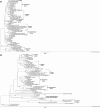Gene encoding the CTP synthetase as an appropriate molecular tool for identification and phylogenetic study of the family Bifidobacteriaceae
- PMID: 29356451
- PMCID: PMC6079163
- DOI: 10.1002/mbo3.579
Gene encoding the CTP synthetase as an appropriate molecular tool for identification and phylogenetic study of the family Bifidobacteriaceae
Abstract
An alternative molecular marker with respect to the 16S rRNA gene demonstrating better identification and phylogenetic parameters has not been designed for the whole Bifidobacteriaceae family, which includes the genus Bifidobacterium and scardovial genera. Therefore, the aim of the study was to find such a gene in available genomic sequences, suggest appropriate means and conditions for asmplification and sequencing of the desired region of the selected gene in various strains of the bacterial family and verify the importance in classification and phylogeny. Specific primers flanking the variable region (~800 pb) within the pyrG gene encoding the CTP synthetase were designed by means of gene sequences retrieved from the genomes of strains belonging to the family Bifidobacteriaceae. The functionality and specificity of the primers were subsequently tested on the wild (7) and type strains of bifidobacteria (36) and scardovia (7). Comparative and phylogenetic studies based on obtained sequences revealed actual significance in classification and phylogeny of the Bifidobacteriaceae family. Gene statistics (percentages of mean sequence similarities and identical sites, mean number of nucleotide differences, P- and K-distances) and phylogenetic analyses (congruence between tree topologies, percentages of bootstrap values >50 and 70%) indicate that the pyrG gene represents an alternative identification and phylogenetic marker exhibiting higher discriminatory power among strains, (sub)species, and genera than the 16S rRNA gene. Sequences of the particular gene fragment, simply achieved through specific primers, enable more precisely to classify and evaluate phylogeny of the family Bifidobacteriaceae including, with some exceptions, health-promoting probiotic bacteria.
Keywords: Bifidobacteriaceae; Bifidobacterium; CTP synthetase; classification; phylogenetics; scardovia.
© 2018 The Authors. MicrobiologyOpen published by John Wiley & Sons Ltd.
Figures

References
-
- Biavati, B. , & Mattarelli, P. (2012). Genus Bifidobacterium In Whitman W., Goodfellow M., Kämpfer P., Busse H.‐J., Trujillo M., Ludwig W., Suzuki K. & Parte A. Bergey′s manual of systematic bacteriology (pp. 171–206). New York: Springer.
Publication types
MeSH terms
Substances
Associated data
- Actions
- Actions
- Actions
- Actions
- Actions
- Actions
- Actions
- Actions
- Actions
- Actions
- Actions
- Actions
- Actions
- Actions
- Actions
- Actions
- Actions
- Actions
- Actions
- Actions
- Actions
- Actions
- Actions
- Actions
- Actions
- Actions
- Actions
- Actions
- Actions
- Actions
- Actions
- Actions
- Actions
- Actions
- Actions
- Actions
- Actions
- Actions
- Actions
- Actions
- Actions
- Actions
- Actions
- Actions
- Actions
- Actions
- Actions
- Actions
- Actions
- Actions
- Actions
- Actions
- Actions
- Actions
- Actions
- Actions
- Actions
- Actions
- Actions
- Actions
- Actions
- Actions
- Actions
- Actions
- Actions
- Actions
- Actions
- Actions
- Actions
- Actions
- Actions
- Actions
- Actions
- Actions
- Actions
LinkOut - more resources
Full Text Sources
Other Literature Sources

